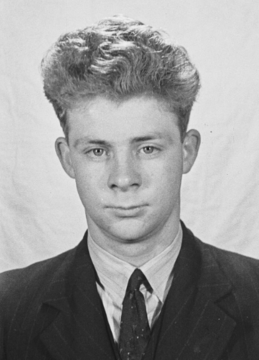DOYLE, Ronald Harrold
| Service Number: | 117502 |
|---|---|
| Enlisted: | 20 August 1942, Melbourne, Vic. |
| Last Rank: | Corporal |
| Last Unit: | No. 43 Squadron (RAAF) |
| Born: | Brighton, Victoria, Australia, 6 September 1923 |
| Home Town: | Hampton, Bayside, Victoria |
| Schooling: | Hampton State School, Brighton Technical College, Melbourne Technical College |
| Occupation: | Motor Mechanic |
| Died: | 30 April 1981, aged 57 years, cause of death not yet discovered, place of death not yet discovered |
| Cemetery: |
Springvale Botanical Cemetery, Melbourne R W Gillard, Row CH, Grave 10 |
| Memorials: | Victorian Garden of Remembrance |
World War 2 Service
| 20 Aug 1942: | Enlisted Royal Australian Air Force, Corporal, 117502, No. 43 Squadron (RAAF), Melbourne, Vic. | |
|---|---|---|
| 9 Feb 1946: | Discharged Royal Australian Air Force, Corporal, 117502 |
Help us honour Ronald Harrold Doyle's service by contributing information, stories, and images so that they can be preserved for future generations.
Add my storyBiography contributed by Faithe Jones
Son of Harold Bartholomew and Grace Margaret DOYLE, 15 Passchendaele Street, Hampton, Vic.
Ronald became a qualified airgunner and armourer in Catalinas and joined Pat Pennys aircrew 6 December 1944. He was involved in 13 secret mining operations, two humanitarian operations and one more operation secretly ferrying Japanese prisoners of war back to Australia after the war.
After their first operation (19 hours flying to mine Japanese occupied Laut Strait Borneo), the whole crew came to the conclusion that they would not survive the war, because their Catalina had so many holes from bullets and flack. They forged on anyway knowing that they would probably be shot down and if they survived that they would be caught and executed. When they accpeted this they weren't as fearful and became known as a 'crack' crew, meaning that they always got to their traget and back no matter what.
So Ron Doyle decided that because theywere involved in secret warfare his family aws going to know what they had done, should he not return, rather than just receiving a notice of being 'missing in action' and not much else. So he hid a camera in his lunch box and after each 'bash' had his girlfriend (Shirley, whom he married after the war and had three children John, David and Debbie) develop the films in a darkroom privately. The crew knew what he was doing and hoped that eventually a copy of the photos would be given to their families should they not return from one of these dangerous operations.
Fortunately they all returned safely and survived the war. So for nine months Ron Doyle flew a total 660 hours of secret Catalina warfare. So this was the background of the photos. They were hidden in his house until the 30 years war secrets act had passed. Ron Doyle had the forsight to realise that people in the future might be interested in waht actually happened with Catalina's after the 30 years had passed. This indeed did happen with many books written.










